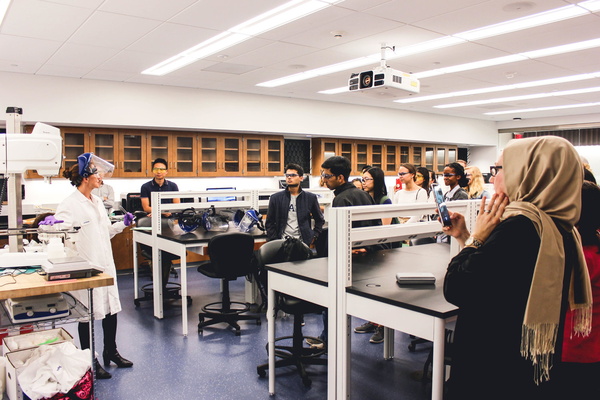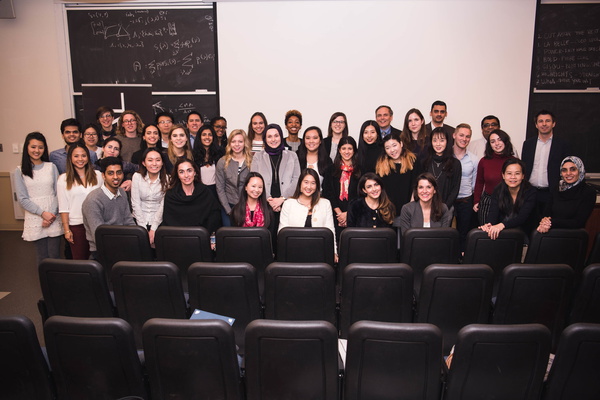Students Develop New Products in Partnership with L'Oréal
Under the bright lights of the Center for Engineering Innovation and Design (CEID), a trio of students ripped into a small collection of Amazon packages. Though their delight with the newly acquired wares may have confused an unknowing spectator walking past the floor-to-ceiling windows on Prospect Street, to Jonara Jimenez, Enrique Martinez, and Diane Yu, the contents of the package — an assortment of pastel-colored foam hair rollers — represented the exciting possibilities for their team, Team Highlights.

The team was participating in the Product Development and Innovation Intensive, a nine-week, extracurricular learning experience put on by the CEID and Tsai CITY in collaboration with L’Oréal. This partnership offered a unique chance for students to learn about innovation in large organizations, exploring the full product development process, from inspiration to launch, along the way.

As the Intensive began on the evening of September 26, the Becton seminar room was milling with students. Vincent Wilczynski, Director of the CEID, and Kassie Tucker, Managing Director of Tsai CITY, observed from behind the mass of students, but the chief instructor of the evening and champion of this pilot program within the halls of L’Oréal was Dr. Seyma Aslan, Manager of Research & Innovation at L’Oréal USA. Standing next to a quartet of wig-sporting busts, Dr. Aslan introduced the goals of the Intensive: to gain exposure to the industry, learn skills to thrive, create novel solutions, and network. Though L’Oréal covers many sectors of the beauty industry, the Intensive teams were to focus on innovation within the hair care and color categories. Dr. Aslan displayed a few L’Oréal innovations — including hair wipes to control frizz and shine, spray-on temporary hair color, and a dry shampoo — to demonstrate the range of products considered innovative. The products circulated around the room for sampling, and students marveled as the hair in the room got decreasingly frizzy and oily and increasingly shiny.
In order to invent a product as game-changing as dry shampoo, though, Dr. Aslan noted that the teams would first need to pin down one of their key soft skills: working together. The teams were pre-assigned and, like the population of the Intensive itself, brought together students from diverse backgrounds. First-years in undecided majors and third-year chemical engineering graduate students would work with MBA candidates and School of Forestry students to address a problem within the hair care industry. For Dr. Aslan, this diversity of thought and background was a key part of both the Intensive and innovation in general. Reflecting partway through the Intensive, she said, “When we designed the model, we made sure that students were coming from diverse backgrounds — this is when a great innovation comes about. Our students are diverse in terms of gender, graduate versus undergraduate…we have people from pharmacology, people from the forestry school, the School of Management, people from history of art. We have all of these different mindsets coming together in a group, and after I saw the projects at the end of one week, I was pleasantly surprised. I said, ‘Wow, this model is actually working!’ The groups are diverse, so the ideas are outside the box.”

As the fall got underway, students got to work developing their projects. They had only one week to ideate before they were expected to submit three ideas, one of which would become their final product. Though they met as teams each week, every other week the entire group would gather to hear from L’Oréal’s experts in research and innovation, operational design, business development, and human resources. The experts from L’Oréal provided insights into everything from their sustainability practices to their equipment cleaning and hiring practices. These discussions pointed to the transferability of key innovation skills: though L’Oréal is the largest cosmetics company in the world, its team’s insights were still applicable to the smaller-scale projects the students were working on within the walls of the CEID. Students also got a chance to use real-world materials as they developed these projects; when Yale didn’t have a highly specific component for the cosmetics projects, Dr. Aslan brought in tools and materials from L’Oréal.
On November 28, in Dunham Laboratory, the program’s seven teams presented these ideas in their pitches to a panel of judges from both Yale and L’Oréal. As Dr. Aslan had predicted, the presentations were outside the box and well executed. Some, in fact, were so well executed that they may have a future beyond the Intensive’s end: these projects provided creative solutions to existing problems, and for L’Oréal it’s a no-brainer to invest in smart solutions. Dr. Aslan said, “We are very excited to see what is to come. This is an experiment for both [Yale and L’Oréal], but in my imagination, we take these ideas further and see if we can patent them and turn them into products. And, of course, the students, the creators, will be a part of this process. If we can get patents and products out of these ideas, it would be tremendous for students and great for the stakeholders at L’Oréal to continue this project.”
As the final pitch-off wound down, the five women of Team Luna took home the first-place prize of $2,000 for their product “Ombré Your Way.” Team Bold won $1,600 for their curl-holding product, and Team Cut Above the Rest earned $1,200 for their hair health product. Though Team Highlights did not place in the top three, Jonora, Enrique, and Diane won the Audience Choice Award, which came with a L’Oréal goody bag full of products that they can now potentially use with their large supply of foam rollers. Though the details of several projects are currently under wraps, perhaps customers will one day see them on drugstore shelves alongside L’Oréal’s vast lineup of industry-changing products.
The feeling in the room at the pitch-off’s conclusion was one of excitement. “We’ll see what happens!,” said Dr. Aslan, noting that the judges from L’Oréal were eager to explore what could happen next with these ideas. The Intensive model, she said, with its open innovation, feedback from experts, and partnership with campus institutions, had exceeded expectations. Even the students who didn’t win prizes were leaving with hands-on experience and face time with experts, as well as a Certificate of Completion in Innovation and New Product Development. As the students milled about, packing up their things, Wilczynski joked above the din, “Okay, who needs a job?” The students laughed, but Omer Imtiaz, L’Oréal’s Director of HR for US Research and Innovation, stood by ready to congratulate the young innovators, just at the start of their careers.